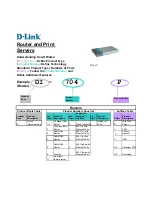
1-2
3) The encapsulated Layer 2 protocol packet (called bridge protocol data unit, BPDU) is forwarded to
PE 2 at the other end of the service provider network, which decapsulates the packet, restores the
original destination MAC address of the packet, and then sends the packet to User A network 2.
Depending on the device models, BPDU tunneling may support the transparent transmission of these
types of Layer 2 protocol packets:
z
Cisco Discovery Protocol (CDP)
z
Device Link Detection Protocol (DLDP)
z
Ethernet Operation, Administration and Maintenance (EOAM)
z
GARP VLAN Registration Protocol (GVRP)
z
HW Group Management Protocol (HGMP)
z
Link Aggregation Control Protocol (LACP)
z
Link Layer Discovery Protocol (LLDP)
z
Port Aggregation Protocol (PAGP)
z
Per VLAN Spanning Tree (PVST)
z
Spanning tree protocol (STP)
z
Uni-directional Link Direction (UDLD)
z
VLAN Trunking Protocol (VTP)
BPDU Tunneling Implementation
The BPDU tunneling implementations for different protocols are all similar. This section describes how
BPDU tunneling is implemented by taking the Spanning Tree Protocol (STP) as an example.
z
The term STP in this document is in a broad sense. It includes STP, RSTP, and MSTP.
z
STP calculates the topology of a network by transmitting BPDUs among devices in the network.
For details, refer to
MSTP Configuration
in the
Access Volume
.
To avoid loops in your network, you can enable STP on your devices. When the topology changes at
one side of the customer network, the devices at this side of the customer network send BPDUs to
devices on the other side of the customer network to ensure consistent spanning tree calculation in the
whole customer network. However, because BPDUs are Layer 2 packets, all STP-enabled devices,
both in the customer network and in the service provider network, can receive and process these
BPDUs. In this case, neither the service provider network nor the customer network can correctly
calculate its independent spanning tree.
To allow each network to calculate an independent spanning tree with STP, BPDU tunneling was
introduced.
BPDU tunneling delivers the following benefits:
Summary of Contents for S7902E
Page 82: ...1 4 DeviceA interface tunnel 1 DeviceA Tunnel1 service loopback group 1 ...
Page 200: ...1 11 DeviceB display vlan dynamic No dynamic vlans exist ...
Page 598: ...ii ...
Page 1757: ...4 9 ...
Page 1770: ...6 4 ...
Page 2017: ...2 11 Figure 2 3 SFTP client interface ...
Page 2238: ...1 16 DeviceA cfd linktrace service instance 1 mep 1001 target mep 4002 ...
















































